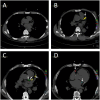Predictive nomogram model for severe coronary artery calcification in end-stage kidney disease patients
- PMID: 38874139
- PMCID: PMC11232636
- DOI: 10.1080/0886022X.2024.2365393
Predictive nomogram model for severe coronary artery calcification in end-stage kidney disease patients
Abstract
Introduction: The Agatston coronary artery calcification score (CACS) is an assessment index for coronary artery calcification (CAC). This study aims to explore the characteristics of CAC in end-stage kidney disease (ESKD) patients and establish a predictive model to assess the risk of severe CAC in patients.
Methods: CACS of ESKD patients was assessed using an electrocardiogram-gated coronary computed tomography (CT) scan with the Agatston scoring method. A predictive nomogram model was established based on stepwise regression. An independent validation cohort comprised of patients with ESKD from multicentres.
Results: 369 ESKD patients were enrolled in the training set, and 127 patients were included in the validation set. In the training set, the patients were divided into three subgroups: no calcification (CACS = 0, n = 98), mild calcification (0 < CACS ≤ 400, n = 141) and severe calcification (CACS > 400, n = 130). Among the four coronary branches, the left anterior descending branch (LAD) accounted for the highest proportion of calcification. Stepwise regression analysis showed that age, dialysis vintage, β-receptor blocker, calcium-phosphorus product (Ca × P), and alkaline phosphatase (ALP) level were independent risk factors for severe CAC. A nomogram that predicts the risk of severe CAC in ESKD patients has been internally and externally validated, demonstrating high sensitivity and specificity.
Conclusion: CAC is both prevalent and severe in ESKD patients. In the four branches of the coronary arteries, LAD calcification is the most common. Our validated nomogram model, based on clinical risk factors, can help predict the risk of severe coronary calcification in ESKD patients who cannot undergo coronary CT analysis.
Keywords: Agatston coronary artery calcification score; End-stage kidney disease; chronic kidney disease-mineral and bone disorders; coronary artery calcification; left anterior descending artery; nomogram.
Conflict of interest statement
The authors have no conflicts of interest to declare. A preliminary version of the manuscript has been published in a preprint form: Tang X et al. [60].
Figures





Similar articles
-
Estimation of cardiovascular risk on routine chest CT: Ordinal coronary artery calcium scoring as an accurate predictor of Agatston score ranges.J Cardiovasc Comput Tomogr. 2017 Jan-Feb;11(1):8-15. doi: 10.1016/j.jcct.2016.10.001. Epub 2016 Oct 5. J Cardiovasc Comput Tomogr. 2017. PMID: 27743881
-
Correlation between coronary calcification and cardiac structure in non-dialysis patients with chronic kidney disease.ESC Heart Fail. 2025 Feb;12(1):199-210. doi: 10.1002/ehf2.15057. Epub 2024 Sep 6. ESC Heart Fail. 2025. PMID: 39239806 Free PMC article.
-
Correlation and predictive value of aortic root calcification markers with coronary artery calcification and obstructive coronary artery disease.Radiol Med. 2017 Feb;122(2):113-120. doi: 10.1007/s11547-016-0707-5. Epub 2016 Nov 14. Radiol Med. 2017. PMID: 27844188
-
Current status and future perspective of coronary artery calcium score in asymptomatic individuals.J Cardiol. 2025 Apr;85(4):275-282. doi: 10.1016/j.jjcc.2024.11.008. Epub 2024 Dec 2. J Cardiol. 2025. PMID: 39631694 Review.
-
Coronary Artery Calcium Assessment in CKD: Utility in Cardiovascular Disease Risk Assessment and Treatment?Am J Kidney Dis. 2015 Jun;65(6):937-48. doi: 10.1053/j.ajkd.2015.01.012. Epub 2015 Mar 6. Am J Kidney Dis. 2015. PMID: 25754074 Review.
Cited by
-
Development and validation of a nomogram for predicting calcification of arteriovenous access in hemodialysis patients.Ren Fail. 2025 Dec;47(1):2542980. doi: 10.1080/0886022X.2025.2542980. Epub 2025 Aug 12. Ren Fail. 2025. PMID: 40798831 Free PMC article.
-
The Impact of the Coronary Artery Calcium Score on the Clinical Outcomes in Patients with Acute Myocardial Infarction.J Clin Med. 2024 Nov 25;13(23):7136. doi: 10.3390/jcm13237136. J Clin Med. 2024. PMID: 39685595 Free PMC article.
-
Individualizing the lifesaving journey for calciphylaxis: addressing rapidly progressive attacks with multidimensional and AI research for regenerative medicine.Ren Fail. 2024 Dec;46(2):2392846. doi: 10.1080/0886022X.2024.2392846. Epub 2024 Sep 5. Ren Fail. 2024. PMID: 39234636 Free PMC article. No abstract available.
References
Publication types
MeSH terms
LinkOut - more resources
Full Text Sources
Other Literature Sources
Medical
